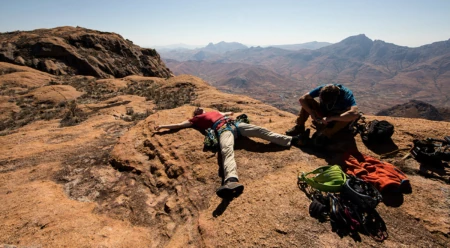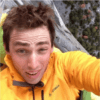Finding Granite and New Limits in Madagascar
I wake early to the dazzling heat of the African sun. Perched 400 meters high on a huge granite face in central Madagascar, all I can see is black and blue, the color of the Malagasy granite meeting the sky and, coincidentally, the same color as large areas of my body from the constant abuse of big walling. The connection a climber has with a climb is often directly proportional to the amount of blood, sweat and tears they’ve expended. I think that’s why I fell in love with this dirty, masochistic and totally deranged genre of climbing.
My hands pulsate, pain throbbing through each digit, little sparks of agony bursting through the blisters and cuts to the rhythm of my heart. That seemed profound until I considered that I just need to get up. If I’ve learned one thing, it’s that the pain goes away when you start moving, but it’s always a hard start. At least it’s not a frozen cliff face. A small red blister seems to be forming on my nose; that will really put a damper on my modeling career.
Madagascar has been a place I’ve wanted to visit since reading about it in Arnaud Petit’s Parois de Légende, a compendium of the best big-wall/multipitch destinations and routes in the world! “Reading” is a relative term since the whole thing is written in French, a language I don’t speak. But between the photos and the occasional words of common etymology, I got the gist of it. Most British climbers have been inspired by Ken Wilson’s Extreme Rock—the foremost collection of the most classic extreme trad routes in the UK—but it is Parois de Légende that piqued my interest. Some of the places it describes seem so exotic and so isolated that getting there is the challenge. I knew that if I never made it happen, it just wouldn’t, so I set about making plans.
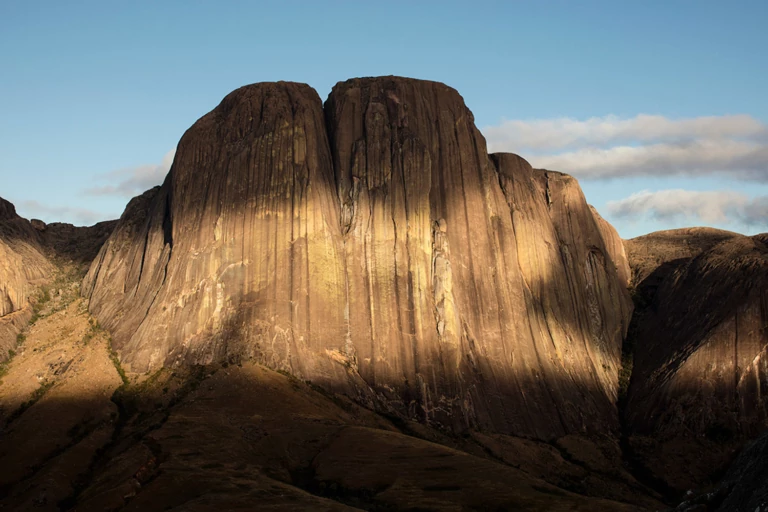
The big blank granite walls of Tsaranoro have inspired me since I was a kid reading about them in Arnaud Petit’s “Parois de Légende. Visiting Tsaranoro and climbing these walls was a dream come true. Photo: Alastair Lee
The Journey
I set out with two friends, Alan Carne (59, British expat living in Verdon, France) and Calum Cunningham (21, a Highlander from northwestern Scotland), and we were joined later by Alastair Lee (filmmaker). The three of us made an unlikely partnership, but we were a team to be reckoned with (if you were a big wall)! The plan was to open a new route on one of the big walls of Tsaranoro, an objective I would never have underestimated, but neither could I have foreseen the trials we would endure.
For me, this trip was more than just a new climbing experience, it was a cultural one. It was chaotic and sensory. There didn’t appear to be any rules in Madagascar; things either happened or they didn’t. If a bus was supposed to arrive at 3 p.m., it might show up an hour, a day or a week later. Who knew? The one thing that was certain, however, was that nobody was in a hurry, so if the bus arrived now or three days from now, it didn’t really matter … except to me.
After several days of chaotic travel, we arrived in Tsaranoro exhausted. But the sight of those big, beautiful granite walls melted our fatigue. As a climber, it’s natural to be drawn to these amazing, jaw-droppingly gorgeous rock formations, but there is something more than just the temptation of the climb that stirs the soul, something that climbers and nonclimbers both feel.
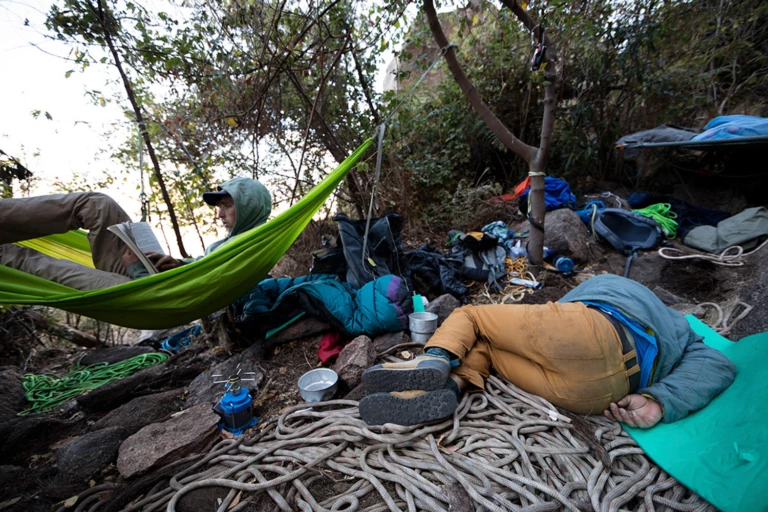
Mum always told me “a tidy house is a tidy mind.” Maybe that’s why mine is a bit messed up! In between stints on the wall, we’d abseil back to the base of the wall and relax. The ground was jagged with rocks and roots, so we slept on the coiled ropes like a mattress. Photo: Alastair Lee
The Beginning
The rock faces of Tsaranoro are almost completely devoid of cracks or seams in which to place natural protection. For this reason, bolts are placed on lead (ground up) during the first ascent to protect the leader from a fall. When I was younger, I couldn’t imagine anyone climbing these blank rock faces, holding on with a few millimeters of rock across their fingertips. I learned that the technique involved placing a forged steel hook, known as a skyhook, on the edge of the face, and then weighting it with your whole body to free your hands to drill and place a bolt. Bloody madness! Years later I would use this method quite a lot in developing big walls, but that feeling of slowly weighting the skyhook, the sound of the rock crunching under the sharp metal tip and the uncertainty of whether the rock would accept it or not still gives me the shivers.
As always with a new venue, it’s important to get the lay of the land. So, we climbed some existing routes in between studying the topos to learn where every route went and what possible hidden free lines remained to be climbed. After a week of exploring, we identified two potential lines on the biggest, the steepest and, in my opinion, the best-looking wall—the 700-meter Tsaranoro Atsimo. One line I was certain would go free. The other line looked much less likely—it was blank and had no neighbors, which in retrospect was a big warning sign. But I hadn’t come to Madagascar to have an easy time; I came for the challenge and for adventure and thus it would have to be the harder line.
After three days on the wall, we hit a dead end. If we had been lucky enough to find holds, this line would have made for an incredible piece of climbing. Without taking the risk of potential failure, however, we couldn’t find the best lines. Luckily, there was still one line left to try.
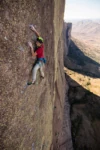
The crux pitch of Blood Moon took five hours to bolt from the ground up. My drill swung at my hip as I cut shapes between hidden features in the rock. My neck ached as I gazed upward, analyzing the vertical world and trying desperately to find an answer to the soaring rocky puzzle. My only respite came when I was skyhooking millimeter-sized edges to place the next bolt—the rock crackled under the metal tooth as the wall decided whether to accept my weight. Tension built until the rock quieted, tolerating my weight, and I could relax. When I finally freed the pitch, I realized that I had found the only line amid the blank granite: a perfect end to a perfect climb! Photo: Alastair Lee
The King Line
I hadn’t noticed before how perfect the other line really was; it wove its way between two gigantic black streaks, painted parallel to each other down almost the entire length of the wall. It reminded me of tire tracks laid down by an enormous race car.
The initial attempt was to bolt and establish the line—we didn’t intend on freeing the route. This style of climbing tends to be quite slow; going bolt to bolt for days, you don’t get pumped but you do get a good feel for the climbing. On the third day, we arrived at the 400-meter point. From the ground, I had spotted the first potential crux, a bulge of steepness in the eternal dark brown slabs. There were three options: to the right looked steep and a little flaky, straight up appeared steep and blank, and the left seemed not as steep and less but it had more edges.
I chose the left, feeling more confident that I could weave my way through the minute crimps on the less precipitous terrain. The next five hours were some of the most exciting climbing I’ve ever done; busting out long reaches between small finger-pad-sized edges, running it out, and then skyhooking on tiny edges to place the next bolt. I giggled my way up the first three quarters of the pitch, delirious with excitement and the prospect of opening one of the most phenomenal pitches of techy face climbing I’d ever seen. In the last 10 meters of the pitch the angle dropped, the color of the rock turned dark and suddenly all the good edges became small, sharp , crystals and spikes. I fought my way up the face, moving by instinct and unlocking the sequence through sheer will and determination. I took several big falls from the crux before breaking through into higher territory and onto a thin 6 millimeter hidden glassy edge that I figured I could skyhook and bolt from.
I was runout here and didn’t fancy the fall from this point, so I placed the skyhook on the edge, sinking slowly onto it, still gripping tightly on to the edges on either side but giving out more and more as my weight was taken by the hook. Then, BANG! The skyhook ripped off and hit me in the mouth. I lost my balance, holding on by one hand before frantically managing to get the other back on the edge. I rolled my tongue over my tooth and felt a sharp point. “Shit!”
Forgetting where I was, I shouted to Alan and Calum, “How much does it cost to get a tooth fixed?” The possible financial threat took priority for a moment before I remembered that I was still holding on to the wall and still very runout above the last bolt. Holding on with one hand, I took the drill and managed to bore into the rock far enough before skyhooking the drill head and sitting on that. With more time on my hands, I looked up and saw the end of the pitch. I knew we could climb this thing!
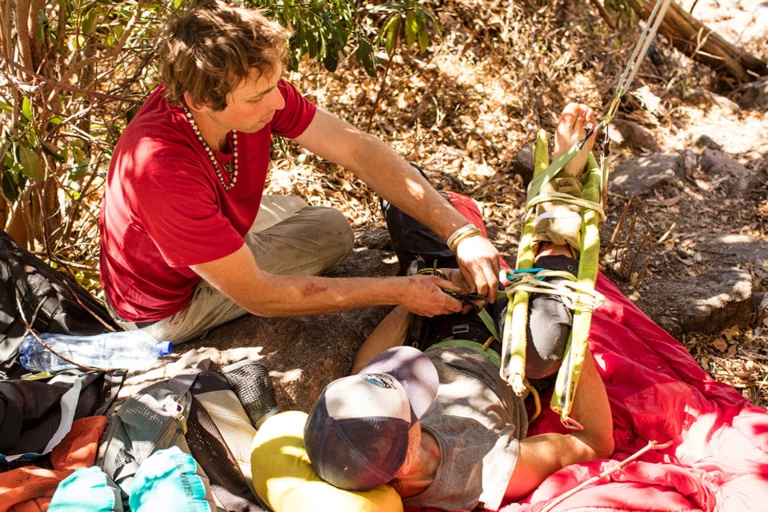
Alan Carne fell while 200 meters up on our first attempt at Blood Moon. An open fracture of his shattered tibia and fibula—we had to get him off the wall and to first aid at the base of the climb. I’d never dealt with anything like this before, but we fashioned a splint out of sticks and rope protectors and elevated his leg with slings tied off to the branch of a small tree. Photo: Alastair Lee
Break a Leg …
After six days on the wall, we established the line; the only thing left to do was climb it. We took a few days to rest and recuperate before heading back up the hill to do battle for the free ascent. Alastair Lee had just joined the team to capture some of the climbing for an upcoming film; the energy was positive and we were psyched.
I barely slept that night at the base of the wall. I just stared at the enormous black entity, a monolithic figure of darkness deeper than the night sky. We’d committed so much time, energy and resources to this climb that I was starting to feel pressure begin to creep in. Time was running out!
That morning was like every other morning in Tsaranoro. The sun rose slowly over the mountains, but the temperature rose viciously by the minute. The sleepless night did little to deter me, and by morning I felt rejuvenated, as if I’d slept soundly in my own bed. There was tension in the air. This was what we’d all been waiting for: The months of preparation and the weeks of arduous labor finding and creating the climb had all led to this moment.
We were only a few pitches into the climb, and it was Alan’s lead. At the belay, he looked a little shaky. He hadn’t properly free climbed in several weeks and his movements seemed rigid, just not like him. I remember wondering if he’d like me to take this lead, but I didn’t ask him. I have a lot of respect for Alan and the last thing I wanted to do was insult him. Besides it was only the first few meters of the pitch and for sure he’d find his flow.
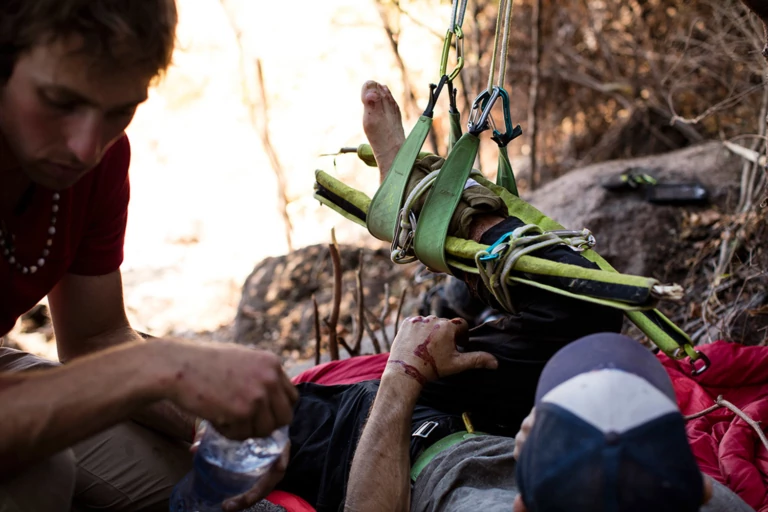
After Alan’s fall, we waited at the base of the wall until a dozen villagers arrived, armed with an old-school stretcher. We took turns carrying him down the long, steep, winding dirt trail all the way back to camp. From there, it was a five-hour drive to Fianarantsoa Hospital, and another 24 hours before he was evacuated to La Réunion, a 1.5-hour flight away. Alan endured the journey with only a few painkillers to ease his agony. Photo: Alastair Lee
Without warning, Alan peeled off the wall, the crispy flake he held in his left hand broke away, and in slow motion I watched as his leg pirouetted around my head, the force throwing him out before the rope caught him midflight, sending him straight back at the wall in a downward arc. Alan’s scream released a tidal wave of fear and shock, followed by the sight of his leg—twisted, mangled and bloody. The realization of the severity of the situation came much later. I went into autopilot just to get him off the wall and onto the relative safety of solid ground. We descended via tandem abseil, Alan cradled in my arms as he screamed and cried into my shoulder. At the base of the wall, Alastair and I administered first aid while we waited for the villagers to arrive with a stretcher.
It took an hour to get Alan off the wall, several more to get him to the village and then a five-hour nightmare drive to the hospital in the back of a cramped station wagon along winding potholed roads. After 24 hours in a hospital largely underprepared to deal with his condition, Alan was evacuated to La Réunion.
Alan’s accident weighed heavily on us. It reminded us of the dangers of our sport and underscored the lack of mountain rescue teams and easily accessible medical support. The risks out here were far greater than we’d anticipated. I wrestled with whether to continue the climb. At the hospital, Alan had said he hoped we’d finish. His was a freak accident. It was certainly something to be aware of, but more than anything, I wanted to go back. It was why we’d come here and, for Alan’s sake, I felt we had to make the climb.
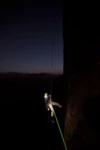
Some people are afraid of the dark, but it’s my favorite time to climb. You only see what you want to see. The 500-meter drop below your feet is illuminated only as far as your headlamp reaches. The bubble of light protects you from the unknown, allowing glimpses of the only things that really matter in the vertical world—the tiny crystals that the edge of your boot smears over, and the granite edges that your fingertips bite to. Photo: Alastair Lee
Back on the Wall!
REPS BEGINNING FIX
Back on the wall and baking in the heat, we were in our second day of our second attempt at this new route and our skin was already suffering. I was lucky enough to climb the crux pitch (5.13c/8a+) on my first attempt in less-than-ideal conditions, but Calum was struggling with the heat. I’ve been dealing with my own demons: the sound of Alan’s screams echoing in my head and the thought of something similar happening to Calum or to me.
Calum’s energy was depleted; his skin was trashed. It made little sense for him to continue to try the crux pitch. And we were burning through our supplies. We were reduced to eating dried porridge mixed with chocolate protein powder. I kept running through different options to allow us the greatest chance of success. Eventually I hatched a plan: Calum would support me that night in trying to get as far up the wall as humanly possible, then we’d abseil back down to the portaledge to give Calum more time the following day to focus on the crux pitch.
At 2 a.m. I was only one pitch from the top of the wall, but it would have to wait—we abseiled back down, essentially undoing all the hard work of that night, but giving us the greatest chance to top out as a team.
Blood, Sweat and Tears
After several failed attempts the next day, Calum desperately scratched his way up the crux pitch. And on yet another long day of climbing, trending well into the late hours of the night, we slowly made it back to where I’d left us the night before, Calum leading the way on all the pitches he was yet to climb before we finally summitted the wall as a team.
No other form of climbing demands so much that by the end you can’t say that the climb hasn’t changed you. Big walling requires you to survive in the harshest environment while pushing your body and mind to the limits of their capabilities and then demanding more. The only way through is intelligence, resilience and unwavering camaraderie. Big walling taught me that the summit is never the reward. It leaves you with something intangible yet invaluable. When we left Madagascar, we left a part of ourselves behind, yet we were more whole than when we arrived; that is the beauty of it, and the reason I fell in love with this dirty, masochistic and totally deranged genre of climbing.
On the Mend …
After two weeks in the hospital, Alan had surgery on his leg. Several months later, recovering at his home in France, his leg still wasn’t healing well. A Malagasy bacterium was found festering in the wound, necessitating yet another surgery. Since then Alan has made a full recovery and has been climbing again in Margalef, Spain. He plans on climbing in the European Alps this summer and will return to Madagascar with me in the near future.
Watch the Film
Blood Moon, the film by Alastair Lee, captures the whole crazy adventure and can be watched online here.
